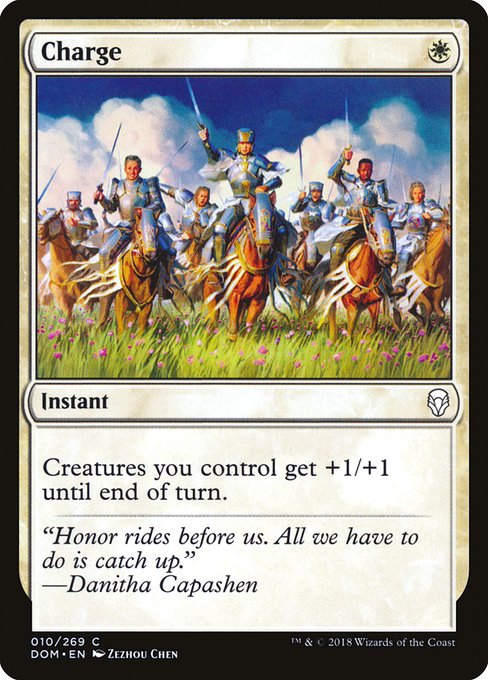
Image courtesy of Scryfall.com
Counterplay Against Charge: Effective Tech Choices
Dominaria brought us a compact white instant that can tilt a board in a heartbeat: Charge costs a single white mana and grants all creatures you control +1/+1 until end of turn. It’s a deceptively simple spell—one mana, one line of text, and a surge of tempo that can be the difference between victory and a tight, grindy loss. As an opponent, you’re not just fighting a single creature or a single combat; you’re contending with a potential avalanche of momentum. The best counterplays aren’t just about blasting away threats—they’re about planning for the moment you foresee the buff and choosing the right tools to blunt its impact. 🧙♂️🔥💎⚔️🎨🎲
Understand the threat: what Charge really does on the battlefield
Charge is an instant aura of pressure. For a single mana, your opponent can pump their entire army by +1/+1 for a turn, enabling sudden trades that would have required more mana or more setup. It shines in creature-heavy decks that flood the board and push through lethal damage in a single swing. The flavor text from Danitha Capashen—“Honor rides before us. All we have to do is catch up.”—feels apt here: the buff forces you to race their tempo, or to disrupt the tempo enough to regain parity. The card is common in Dominaria’s color-wheel, a small but potent reminder that even one-mana spells can reshape outcomes. 🧭🧙♂️
Top tech picks to counter Charge: a practical toolkit
- Counterspells and tempo denial — Deny the buff before it lands. A lean blue control shell loves Counterspell or Swan Song to shut down Charge entirely, while budget-friendly options like Cancel variants or Disallow can buy you the time to find your own disruption. In any case, the goal is to prevent the buff from resolving and forcing your opponent to rebuild their board without the expected payoff. 🧙♂️
- Board wipes and reset engines — When the buff hits, sometimes a clean slate is the most efficient answer. Wrath effects (Wrath of God, Damnation, or a modern Austere Command) or pure mass bounce (Terminus, Evacuation) reset the battlefield and remove the advantage Charge tried to create. The moment after a wipe, you’ll often find yourself with a chance to regain control and pivot into your plans. 🔥
- Mass bounce for tempo and tempo-proofing — Cards that bounce all creatures on the battlefield, such as Terminus or Cyclonic Rift (in multi-player contexts), can instantly snap the board back to neutral. Even if your opponent replays creatures, the tempo swing buys you critical turns to assemble answers and pressure without overcommitting into an overbearing buff. 🎨
- Targeted removal for threats you fear most — Sometimes you don’t need to erase the whole board; removing the biggest threat that benefits most from Charge’s buff can swing trades in your favor. Swords to Plowshares or Path to Exile are efficient tools to pick off a high-impact attacker, stalling the buff’s most explosive implications. This approach pairs well with a lean disruption plan that doesn’t overdraw removal or clog your hand. 🗡️💎
- Protection for your own board — If you’re aiming to push through damage anyway, protection can be the mercy you need. Cards like Heroic Intervention grant indestructible his and can shield critical creatures from removal while you grind out a victory. This route is especially effective when you’ve already established a board and want to weather a single-turn buff spike. 🛡️
- Defensive stalling and delaying tempo — Fog effects such as Moment's Peace or other preventative spells buy you a turn or two to find an answer. The aim isn’t perpetual stall but ensuring you don’t walk into a single, explosive buff that ends the game prematurely. Timing is everything here; you want the buff to land when you’re ready with a plan. 🧭
- Card draw and threat density — Drawing into more disruption or removal is crucial when you’re facing a recurring buff spell. A robust draw engine helps you locate the right pieces—counterspells, removal, or bounce—before Charge cycles through another hand of threats. The more options you have, the more confident you’ll feel in refusing to overcommit. 📚
Beyond the cards: mindset and deck-building tips
Charge isn’t just a line of text; it embodies a design philosophy from Dominaria-era spells—that tempo can be pushy, but the right counterplay can restore balance with surgical precision. The key is to anticipate the moment you’ll be asked to commit to the board and to equip yourself with tools that don’t just answer the current threat but also prepare for what follows. If your plan is tempo-focused, lean into counterspells and cheap disruption; if you prefer a midrange or control approach, fill in with board wipes, bounce, and resilient threats that can weather a single buff and still win the late game. 🧙♂️💎
As you experiment with these tech picks, remember that the best counters often come from understanding your opponent’s likely line. If they’re token-heavy, you’ll want more sweepers and bounce; if they lean on a few big threats, targeted removal and protection can slow the clock effectively. The beauty of Magic is the endless interplay—the way one small decision can redirect an entire game. And yes, your workspace matters too; the right gear can make all the difference in a tight moment. 🧙♂️🎲
For readers who like a touch of color in their setup while they debate the next move, a little gear crossover never hurts. Check out this Neon Mouse Pad option that can brighten your play area without breaking the bank. It’s a stylish companion for those long, grindy sessions when you’re weighing Charge’s tempo window and your own path to victory. If you’re curious, you can explore more from the shop here: https://shopify.digital-vault.xyz/products/rectangular-gaming-neon-mouse-pad-1-58mm-thick. 🧙♂️🎨